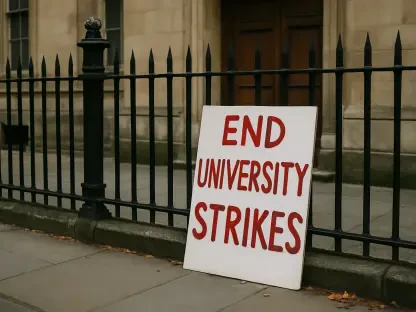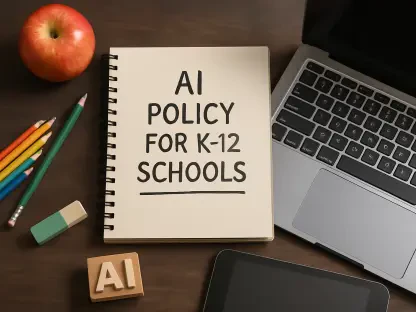Imagine a classroom where essential tutoring programs vanish overnight, teachers face layoffs, and after-school activities that spark creativity and ambition are suddenly cut, leaving students without vital opportunities. This is the harsh reality unfolding across American school districts in 2025 due to a federal funding freeze for the current school year. With billions of dollars withheld despite Congressional approval, educators and administrators are scrambling to maintain educational quality. This roundup dives into diverse perspectives from superintendents, advocacy groups, and educational analysts to explore the profound impacts on students and uncover potential paths forward in this pressing crisis.
Voices of Concern: The Scope of the Funding Crisis
A broad consensus among school district leaders highlights the severity of the federal decision to freeze funds for the 2025-2026 school year. Survey data collected from 628 superintendents spanning 43 states reveals that 85% of districts are now forced to cover existing contracts with already strained local budgets. Many administrators express frustration over the sudden disruption, noting that these funds, typically released by early July, are vital for planning and sustaining educational services.
Advocacy organizations emphasize the national scale of this issue, pointing out that the freeze creates a domino effect across state and local systems. Their stance is clear: without immediate federal intervention, the foundation of public education risks crumbling. Some argue that the Administration’s decision undermines Congressional intent, creating a policy deadlock that leaves students as the primary victims of bureaucratic delays.
Contrasting views emerge on the feasibility of local solutions. While certain district leaders believe temporary budget reallocations can mitigate short-term damage, others warn that such measures merely delay inevitable cuts. This divergence underscores a critical tension: balancing immediate needs against long-term educational stability remains a daunting challenge for many.
Breaking Down the Impacts: What Stakeholders Are Saying
Academic Support at Risk: A Core Concern
Superintendents across the nation report that 75% of their districts are preparing to slash essential academic resources like literacy coaching and extended learning programs. This alarming trend, drawn from comprehensive survey responses, reflects a grim reality where students may lose access to foundational support systems. Many administrators lament that these cuts strike at the heart of educational equity, disproportionately affecting underprivileged communities.
Educational analysts weigh in with a broader perspective, suggesting that the reduction in tutoring and math support could widen achievement gaps already exacerbated by prior disruptions. Their analysis points to a potential long-term decline in student performance if local budgets cannot bridge the funding shortfall. The consensus is that quality education hangs in a precarious balance, with no easy fix in sight.
Differing opinions surface on how to prioritize remaining resources. Some district leaders advocate for preserving core classroom instruction over supplemental programs, while others argue that targeted interventions for struggling students must take precedence. This debate reveals the agonizing choices forced upon educators grappling with financial constraints.
Staff Layoffs: A Direct Hit to Student Support
Half of the surveyed districts anticipate layoffs, particularly among staff dedicated to English-language learners and special education students. Administrators describe this as a devastating blow, with specialized roles critical to vulnerable populations being the first on the chopping block. The loss of these educators threatens to dismantle tailored support structures that many students rely on for academic success.
Insights from educational equity advocates highlight the ripple effects of such reductions. They argue that cutting these positions not only hampers individual student growth but also undermines broader goals of inclusivity in schools. Concerns are raised about the potential for permanent setbacks if skilled staff leave the profession entirely due to instability.
On the other side, a minority of budget-focused analysts suggest that temporary staffing reductions might be a necessary evil to maintain fiscal health. However, even they acknowledge the risk of diminished trust between educators and districts, which could complicate recovery efforts if funding is eventually restored. This split in perspective illustrates the complex trade-offs at play.
Extracurricular Cuts: Limiting Holistic Development
A significant number of districts—around 50% of those surveyed—plan to reduce after-school and extracurricular activities, including programs in STEM, arts, and advanced coursework. Superintendents express deep regret over these decisions, noting that such opportunities often inspire students to pursue future careers and develop critical skills outside traditional academics.
Regional variations add another layer of complexity, as some areas prioritize retaining sports over arts, while others focus on preserving technology initiatives. Analysts point to partial fund releases, such as specific allocations for after-school programs announced mid-year, as offering limited relief. Yet, they caution that these stopgap measures fail to address the broader funding shortfall impacting diverse enrichment activities.
Advocacy groups challenge the perception that extracurriculars are expendable, arguing that they play an indispensable role in fostering well-rounded individuals. Their position is that neglecting these programs risks stunting students’ social and emotional growth, creating deficits that standardized tests cannot measure. This viewpoint pushes back against purely budget-driven decision-making.
Professional Development: An Overlooked Casualty
An often-under-discussed consequence is the impact on educator training, with 80% of superintendents reporting cuts to professional development in key areas like technology integration and core subject mastery. Many express concern that without updated skills, teachers may struggle to adapt to evolving classroom demands, ultimately affecting student outcomes.
Educational researchers draw parallels to past funding delays, suggesting that diminished training opportunities can lead to stagnation in teaching practices over time. They warn of a future where American classrooms fall behind global standards if educators lack access to modern methodologies. This long-term risk adds a sobering dimension to the current crisis.
Some district leaders, however, propose reallocating minimal resources to prioritize training in high-need areas, even at the expense of other programs. This pragmatic approach contrasts with broader calls from teacher unions for full funding restoration to safeguard professional growth. The divide highlights a critical need for strategic planning amidst uncertainty.
Charting the Path Ahead: Collective Insights and Solutions
Synthesizing the varied perspectives, it’s evident that the funding freeze poses a multifaceted threat—from academic service cuts to staff losses and beyond. Survey results underscore the urgency, with 29% of districts nearing critical deadlines for program elimination. Superintendents and advocates alike stress that delayed action could irreparably harm student learning and equity across the board.
Actionable strategies emerge from this collective discourse, including intensified advocacy for the release of all withheld funds. Organizations push for grassroots efforts, encouraging communities to engage with policymakers to elevate education as a national priority. Additionally, temporary local funding solutions are floated as a means to buy time, though their sustainability remains in question.
Another key takeaway is the importance of unified communication between stakeholders. Analysts suggest that transparent dialogue about budget priorities can help districts mitigate the worst impacts while awaiting federal resolution. This collaborative spirit, many argue, is essential to navigating the immediate fallout and preserving educational quality for students.
Reflecting on the Crisis: Steps Taken and Future Actions
Looking back, the dialogue among superintendents, advocates, and analysts painted a stark picture of an education system under strain due to the FY25 funding freeze. Discussions revealed deep concerns over slashed programs, lost staff, and diminished opportunities, with a shared recognition of the immediate harm to students nationwide. The urgency expressed by district leaders underscored a pivotal moment in addressing systemic funding challenges.
Moving forward, stakeholders must prioritize sustained advocacy to unlock frozen funds, ensuring that policymakers understand the gravity of the situation. Communities are encouraged to explore innovative partnerships, such as private sector collaborations, to temporarily bolster school budgets. Furthermore, fostering resilience through strategic resource allocation can help districts weather this storm while planning for a more stable future.









